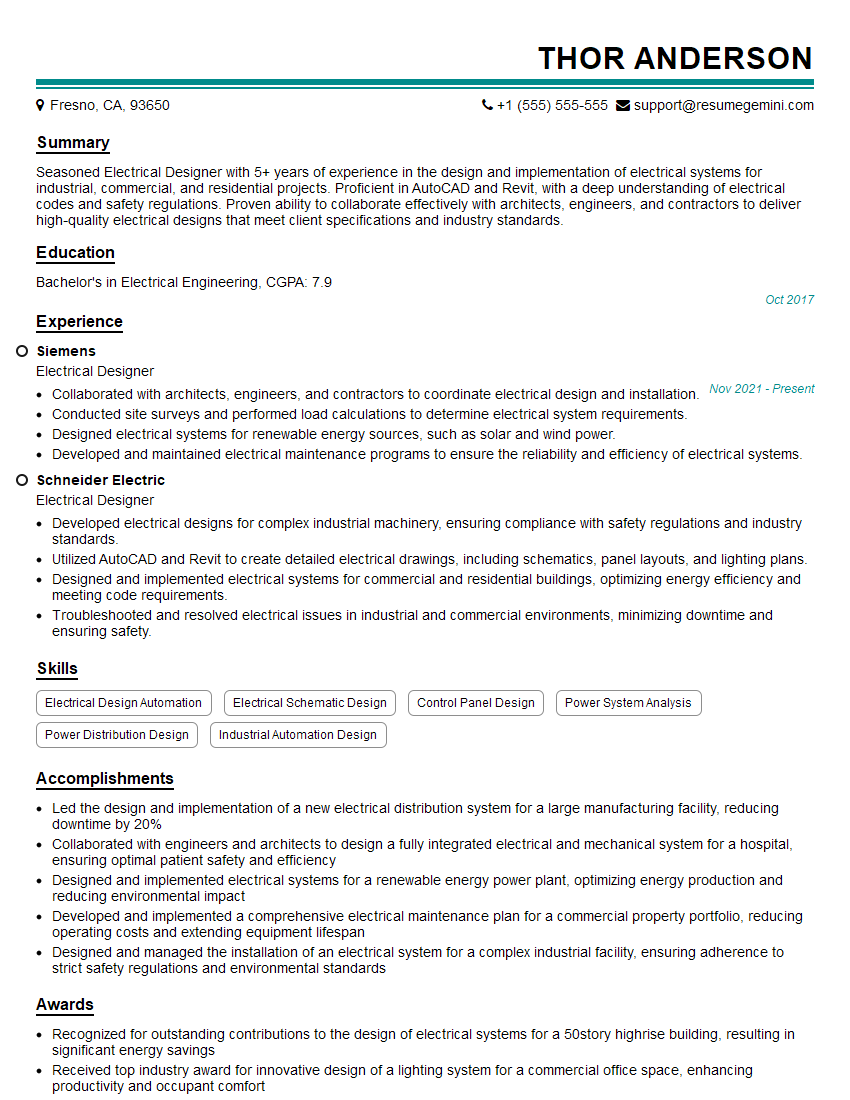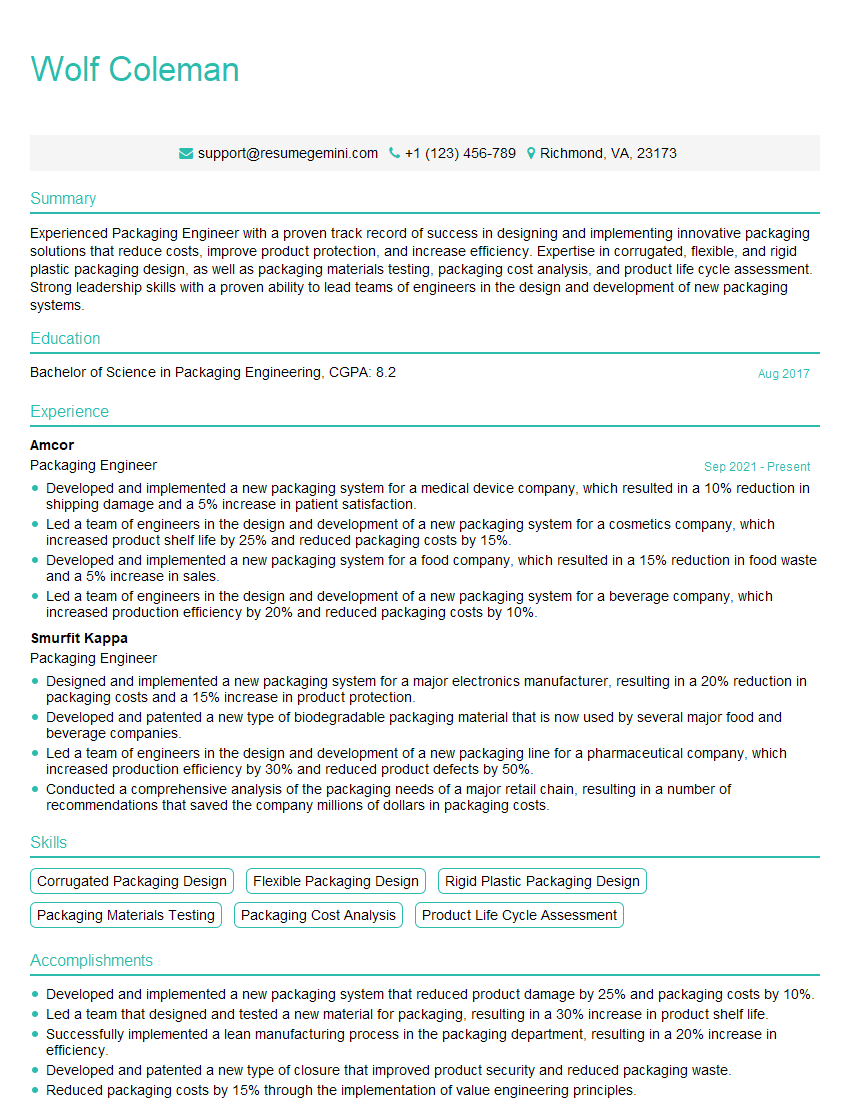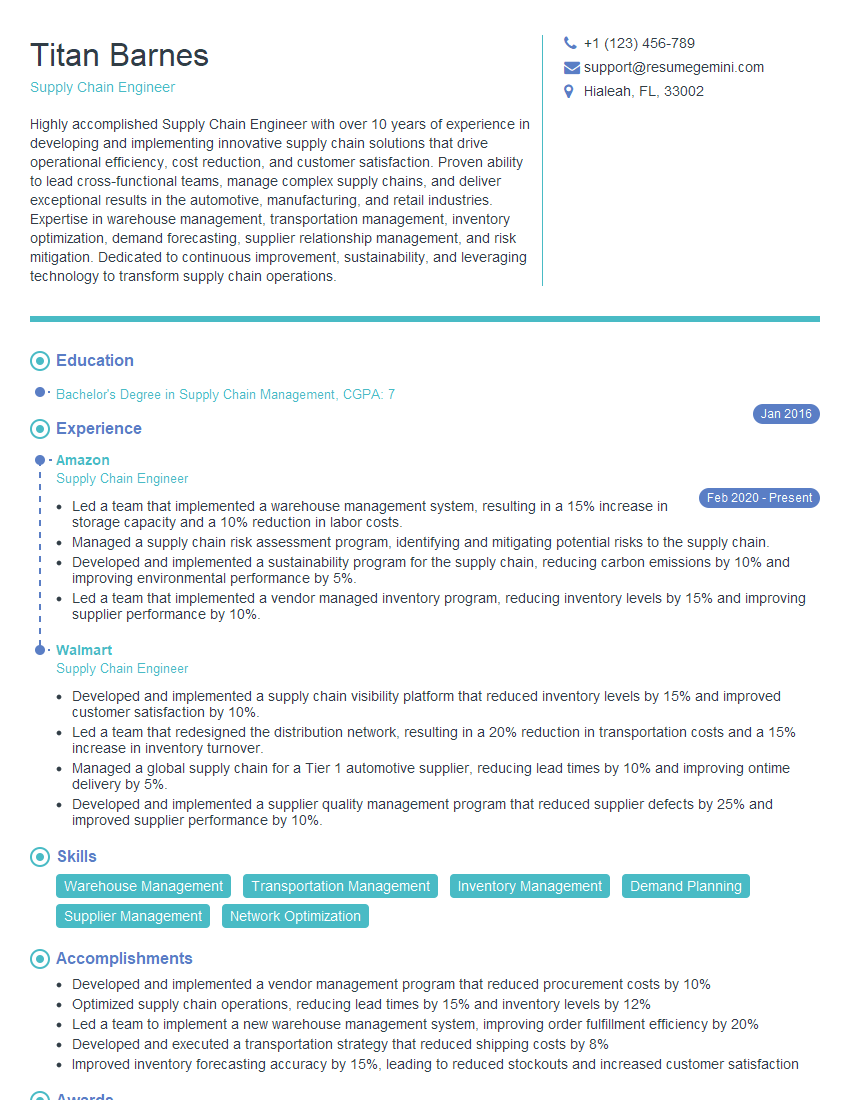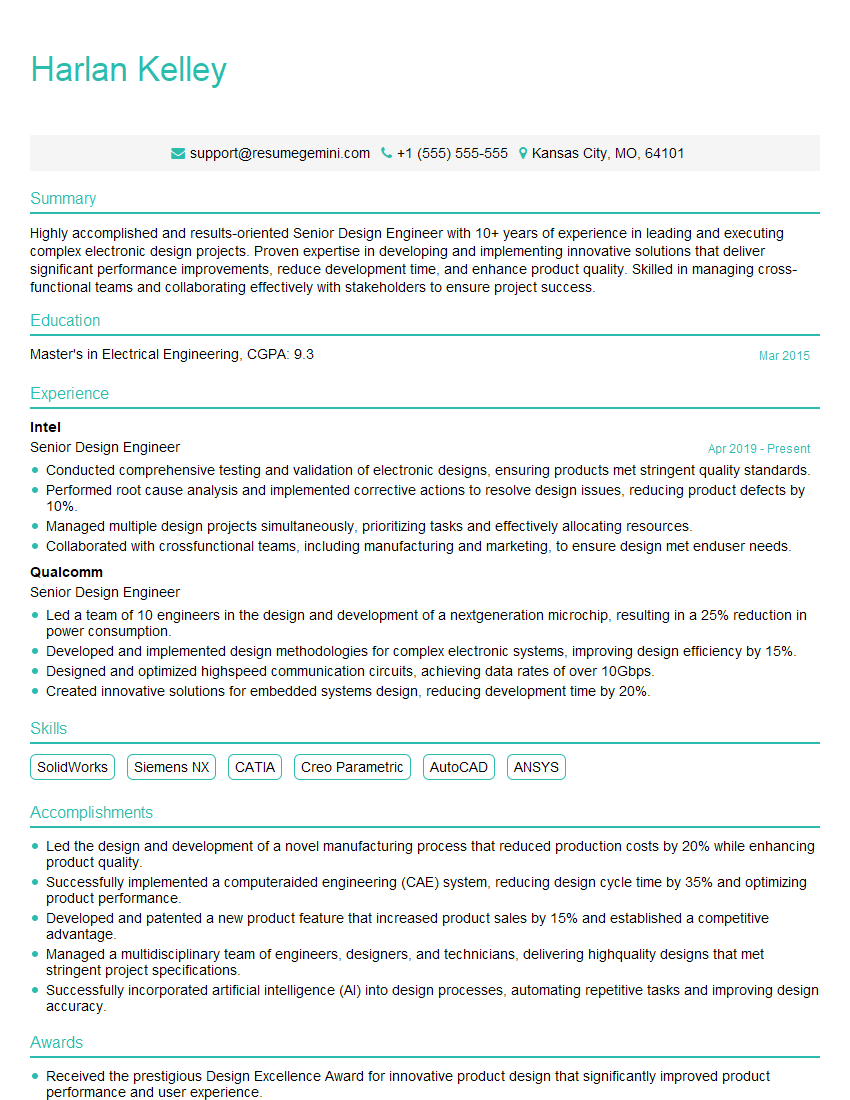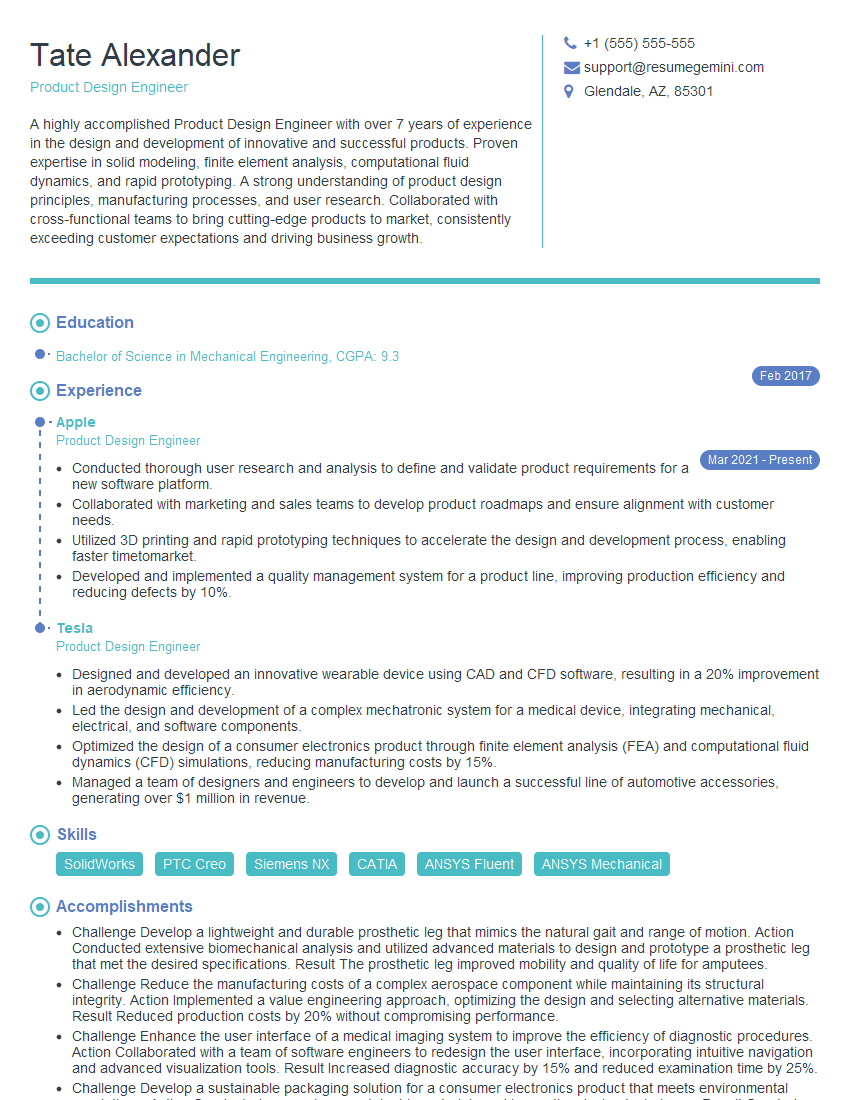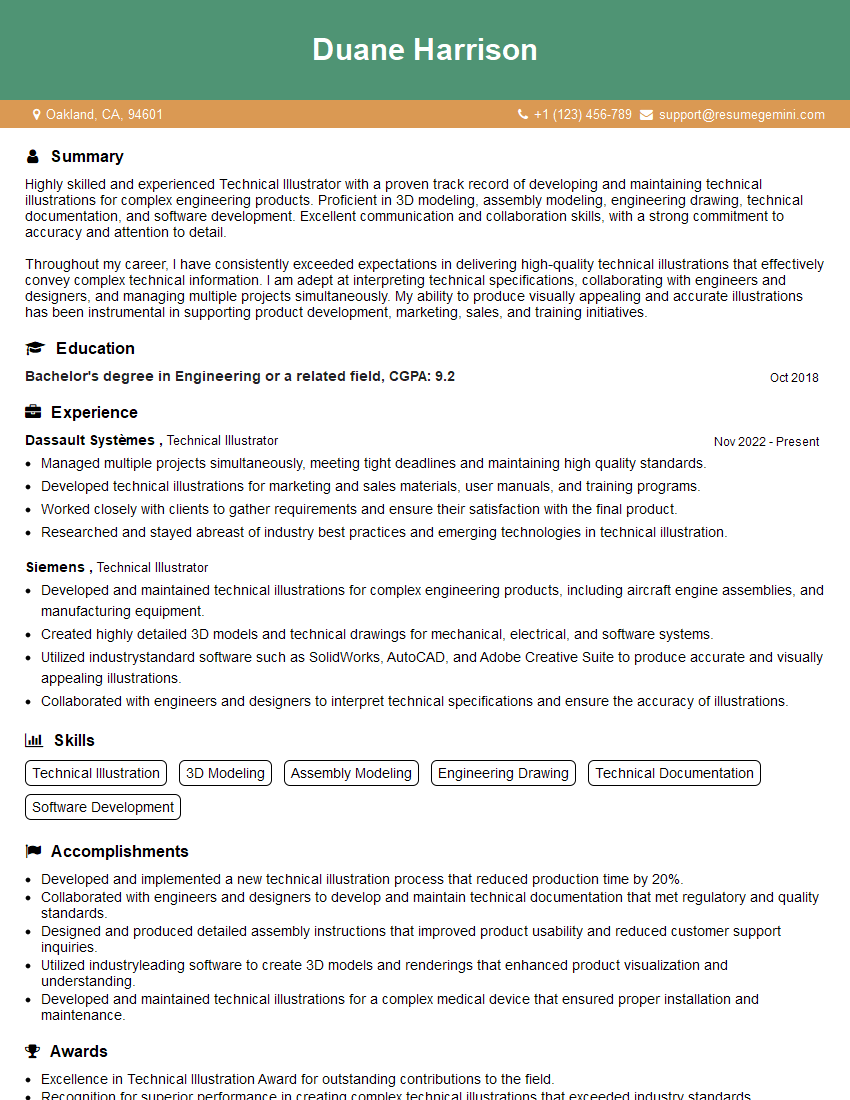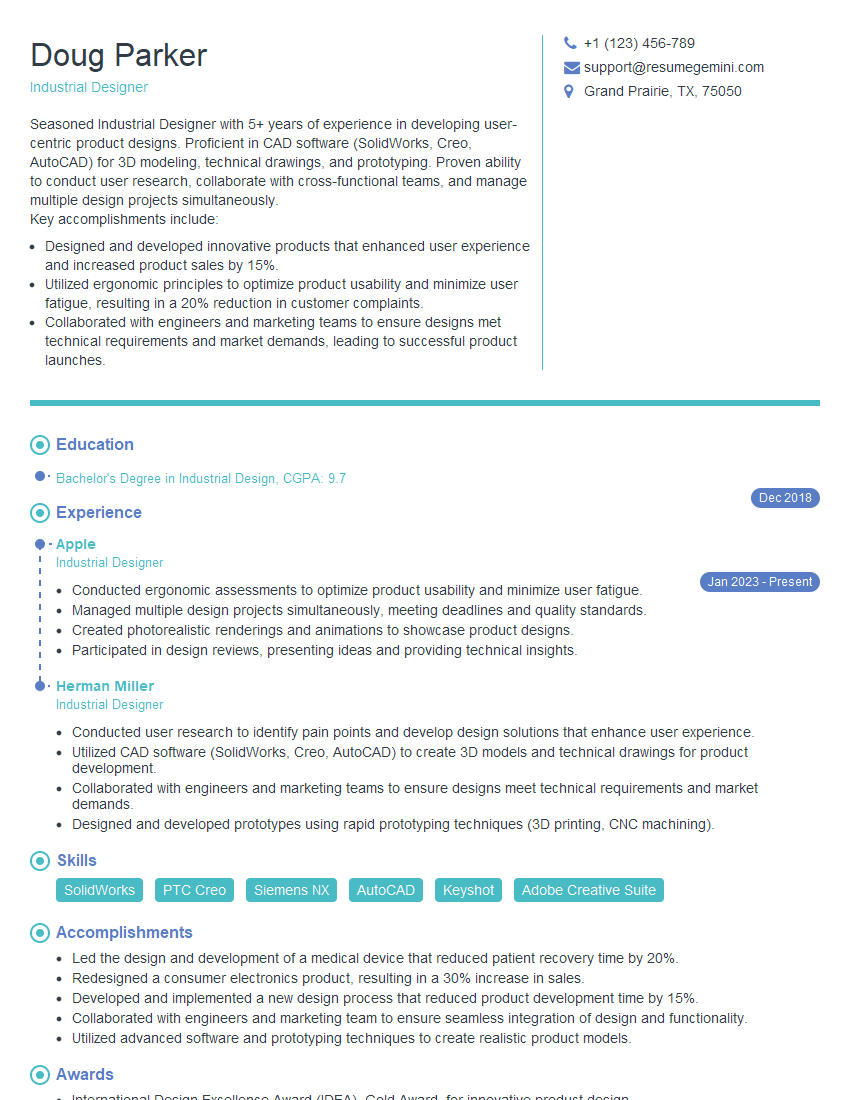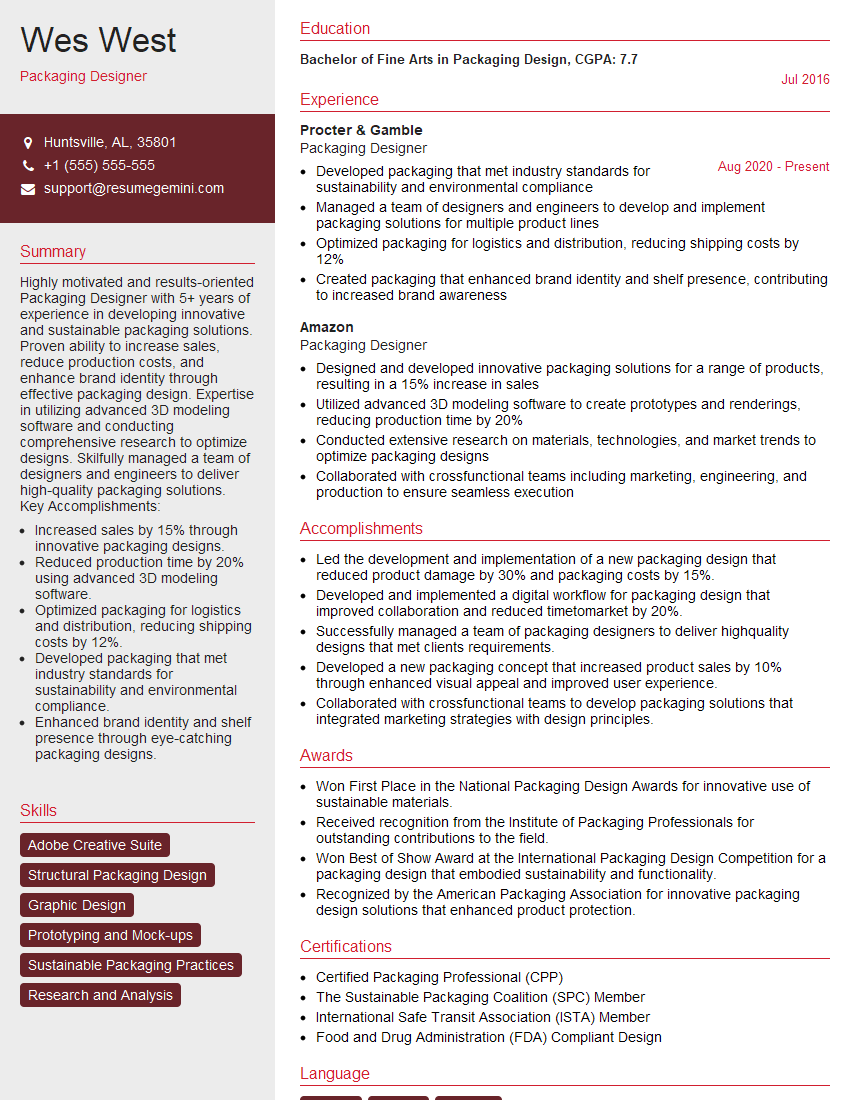Warning: search_filter(): Argument #2 ($wp_query) must be passed by reference, value given in /home/u951807797/domains/techskills.interviewgemini.com/public_html/wp-includes/class-wp-hook.php on line 324
Interviews are more than just a Q&A session—they’re a chance to prove your worth. This blog dives into essential Collaborate with engineers and designers to resolve drawing and box issues interview questions and expert tips to help you align your answers with what hiring managers are looking for. Start preparing to shine!
Questions Asked in Collaborate with engineers and designers to resolve drawing and box issues Interview
Q 1. Describe your experience resolving discrepancies between design drawings and physical prototypes.
Discrepancies between design drawings and physical prototypes are unfortunately common in product development. My approach involves a systematic investigation to pinpoint the source of the error. This starts with a thorough visual inspection, comparing the drawing dimensions and tolerances with the actual prototype. I then use precise measuring tools like calipers and micrometers to quantify any discrepancies.
For example, I once worked on a project where the prototype’s housing was 2mm wider than specified in the CAD drawing. This seemingly small difference prevented proper assembly with another component. By carefully examining the manufacturing process documentation, we discovered that a slight misalignment in the injection molding machine was the culprit. We corrected this issue by adjusting the machine settings, ensuring future prototypes adhered to the original design specifications.
Beyond simple measurements, I also examine the material properties and surface finish for deviations. This often requires understanding the manufacturing process. Sometimes, minor adjustments to the manufacturing techniques might be necessary for a better match between the drawings and the final product.
Q 2. Explain your process for identifying the root cause of a packaging design flaw.
Identifying the root cause of a packaging design flaw requires a structured approach. I typically begin with a thorough visual inspection of the flawed packaging, documenting all observations with photos and detailed notes. I then work backward, systematically eliminating potential causes. This often involves understanding the entire packaging process, from design to printing to filling and sealing.
For instance, if a box is consistently collapsing under weight, I would examine several factors: the material’s strength and thickness, the box’s design (including the number and placement of folds and seams), the quality of the adhesive used, and the filling and sealing procedures. I might even conduct controlled experiments – for example, using different adhesive types or applying additional pressure to specific areas of the box to see how these variables impact its strength.
Root cause analysis techniques like the ‘5 Whys’ can be very helpful. Repeatedly asking ‘why’ helps to drill down to the fundamental reason behind the flaw. Effective documentation and teamwork are essential for success. Using a shared online document for tracking issues and sharing findings helps improve communication and collaboration.
Q 3. How do you collaborate with engineers and designers to find efficient solutions to design issues?
Collaboration is key to efficiently resolving design issues. I firmly believe in open communication and a proactive approach. My process usually involves regular meetings with engineers and designers, where we collaboratively review the problematic area. I encourage everyone to share their expertise and perspectives freely, fostering a non-judgmental environment where all ideas are welcomed.
We often leverage visual aids like 3D models and annotated drawings to highlight the issue and brainstorm solutions. I find that using a whiteboard or shared online document helps us visualize the problem and the different potential solutions simultaneously. We carefully weigh the pros and cons of each solution, considering factors like cost, manufacturability, and the overall design aesthetic. We often establish clear roles and responsibilities to ensure accountability and efficient execution.
A good example involved redesigning a product enclosure that was too difficult to assemble. By combining the engineer’s manufacturing expertise, the designer’s aesthetic input, and my understanding of drawing specifications, we successfully created a revised design that simplified assembly while maintaining the original design’s visual appeal.
Q 4. What CAD software are you proficient in, and how have you used it to resolve drawing issues?
I am proficient in several CAD software packages, including SolidWorks, AutoCAD, and Fusion 360. My expertise extends beyond simply creating drawings; I can leverage these tools to troubleshoot design issues directly.
For instance, I frequently use SolidWorks’ simulation tools to analyze stress and strain on a design, identifying potential points of failure. In AutoCAD, I use the precise measuring and dimensioning tools to detect minor discrepancies between designs and prototypes. The parametric modeling capabilities of Fusion 360 allow me to quickly make design iterations and evaluate their impact on manufacturing feasibility.
I once used SolidWorks to identify a critical interference in a complex assembly, highlighted by the software’s collision detection feature. This avoided a costly and time-consuming manufacturing error early in the production phase.
Q 5. Have you ever experienced a conflict between design aesthetics and manufacturing feasibility? How did you resolve it?
Conflicts between design aesthetics and manufacturing feasibility are inevitable. My approach involves finding a balance that satisfies both needs. It’s not about compromise, but finding creative solutions that address both constraints.
I recall a project where the initial design featured intricate, highly detailed surface textures. While aesthetically pleasing, these textures proved extremely difficult and costly to manufacture using the chosen production method. Instead of simply simplifying the design, we explored alternative manufacturing techniques that could retain the design intent without compromising quality or cost. We ultimately found a solution involving a slightly modified texture that could be achieved through a more cost-effective injection molding process.
Open communication with the designer and the manufacturing team is vital in this scenario. I always begin by trying to understand the designer’s vision and explain the limitations imposed by manufacturing. Then we brainstorm together, researching possible alternatives. The key is to find a solution that is both aesthetically pleasing and feasible, thereby preserving the overall design integrity.
Q 6. Describe a time you had to rework a design drawing due to manufacturing constraints.
I remember a project where the initial design of a component called for a complex curve that was very difficult to produce accurately using the chosen manufacturing process (CNC machining). The initial design’s manufacturing tolerances were too tight, leading to high rejection rates and production delays.
To address this, I worked closely with the manufacturing engineers to identify the constraints and propose design modifications. This involved simplifying the curve and reducing the required tolerance. We utilized the CAD software to create a revised design that was both manufacturable and functionally equivalent to the original design. The modified design significantly improved the production yield, while minimizing any impact on functionality and appearance. The rework process required meticulous attention to detail to ensure dimensional accuracy and maintain the critical design aspects.
This experience underscored the importance of continuous communication between the design and manufacturing teams throughout the product development process.
Q 7. How do you ensure that design drawings accurately reflect the final product?
Ensuring design drawings accurately reflect the final product is paramount. My approach involves a multi-step process that begins even before the initial design is finalized. This includes detailed discussions with the manufacturing team to understand their capabilities and limitations.
Throughout the design process, I rigorously check drawings against design specifications, material properties, manufacturing tolerances, and assembly requirements. I use various CAD tools for verification, including geometric dimensioning and tolerancing (GD&T) checks to ensure proper accuracy. We conduct regular design reviews with cross-functional teams to catch potential issues early on.
Before production, we always create and review prototypes, meticulously comparing them to the finalized design drawings. These prototypes undergo rigorous testing to identify any discrepancies and verify functionality and manufacturability. Any necessary adjustments to the design drawings are documented and implemented before mass production. Finally, a thorough first article inspection is done before full-scale production to ensure that the final product matches the design specifications and drawings.
Q 8. Explain your understanding of Design for Manufacturing (DFM) principles.
Design for Manufacturing (DFM) is a crucial methodology that integrates manufacturing considerations into the product design process from the very beginning. It aims to optimize the design for efficient and cost-effective production while ensuring high quality and reliability. This involves understanding manufacturing processes, material properties, assembly techniques, and limitations to prevent design flaws that could lead to manufacturing challenges or defects later on.
For example, DFM principles would guide us to avoid designs with intricate geometries that are difficult to machine or mold. Instead, we would opt for simpler shapes that are easily produced and minimize waste. Another example is considering the selection of materials. We might choose a material that’s readily available and less expensive but still meets the required performance characteristics, instead of selecting a costly, exotic material that complicates the manufacturing process.
- Material Selection: Choosing materials readily available and suitable for the chosen manufacturing process.
- Part Simplification: Reducing the number of parts and simplifying their geometries.
- Assembly Considerations: Designing for ease of assembly, minimizing the number of fasteners and simplifying the assembly sequence.
- Tolerance Analysis: Ensuring dimensional tolerances are achievable and cost-effective.
- Manufacturing Process Selection: Choosing the most appropriate and efficient manufacturing method.
Q 9. How do you use tolerance analysis in resolving drawing and box issues?
Tolerance analysis is a critical part of resolving drawing and box issues, especially in packaging design. It helps determine the acceptable variation in dimensions for each component to ensure the final product fits correctly and functions as intended. We use tolerance analysis to assess whether the tolerances specified in the drawings allow for the successful assembly and operation of the product. If there are issues, we work closely with the engineers and designers to revise the tolerances.
For example, imagine a box designed to hold a fragile item. If the box’s internal dimensions have too tight tolerances, the item might not fit, resulting in damage or rejection. Conversely, too loose tolerances could lead to excessive movement, again causing damage. Tolerance analysis enables us to determine the optimal range of dimensions to balance manufacturability and functionality. We use statistical methods and software tools to model the tolerances and identify potential problems before production begins. This might involve adjusting the drawing specifications, selecting more precise manufacturing processes, or redesigning components to improve fit.
Q 10. What are some common problems encountered in packaging design?
Common problems in packaging design range from the purely functional to aesthetic issues. Some common ones include:
- Insufficient protection: The package doesn’t adequately protect the product during shipping and handling, resulting in damage.
- Poor fit: The product doesn’t fit snugly within the package, leading to movement and potential damage.
- Difficult opening/closure: The package is difficult to open or close, leading to frustration for the consumer and potentially causing product damage.
- Material limitations: The chosen materials are not suitable for the intended application (e.g., not strong enough, not environmentally friendly, or not recyclable).
- Cost overruns: The packaging is too expensive to manufacture due to complex designs or the use of premium materials.
- Aesthetics: The packaging is not visually appealing or doesn’t effectively communicate the product’s features and benefits.
- Sustainability concerns: The packaging is not environmentally sustainable, using excessive materials or non-recyclable components.
Addressing these issues requires collaboration between engineers, designers, and manufacturing personnel to find effective solutions while balancing cost and performance.
Q 11. How do you handle changes in design specifications during the manufacturing process?
Handling design changes during manufacturing requires a structured and controlled approach. The first step is to thoroughly assess the impact of the changes on existing components, processes, and schedules. A formal change request process is typically followed, involving documentation of the change, impact analysis, cost estimation, and approval from relevant stakeholders. Once approved, the changes are communicated to the manufacturing team through revised drawings, specifications, and work instructions.
This often involves updating the Bill of Materials (BOM), revising manufacturing procedures, and possibly retraining personnel. Careful monitoring is crucial to ensure the implementation of changes goes smoothly and doesn’t disrupt the production process unnecessarily. This is where robust change management software and processes are invaluable in tracking and managing the effects of those changes across the entire process.
Q 12. Describe your experience with GD&T (Geometric Dimensioning and Tolerancing).
Geometric Dimensioning and Tolerancing (GD&T) is a standardized system for defining and communicating engineering tolerances on drawings. It uses symbols and notations to specify the acceptable variations in a part’s geometry, ensuring consistent and accurate manufacturing. My experience with GD&T involves interpreting GD&T symbols on drawings, applying them during design reviews, and ensuring that the manufacturing process adheres to the specified tolerances. I’m familiar with various GD&T features, including position, form, orientation, and runout, and how they affect the overall part quality and assembly fit.
For example, I’ve used GD&T to specify the permissible deviation in the position of a hole relative to other features on a part. This helps prevent misalignment during assembly. I’ve also used GD&T to define the acceptable surface roughness, ensuring the part’s functionality and appearance meet the required standards. Proficiency in GD&T is essential for minimizing errors and reducing rework during the manufacturing process.
Q 13. How do you prioritize competing design requirements (e.g., cost, aesthetics, functionality)?
Prioritizing competing design requirements (cost, aesthetics, functionality) involves a balanced approach that considers the overall project goals and constraints. We often use a weighted scoring system, where each requirement is assigned a weight reflecting its relative importance. Then, different design options are evaluated based on how well they meet each requirement. The option with the highest overall score is often selected.
For instance, if functionality is paramount, we might accept a higher manufacturing cost to achieve superior performance. If cost is the primary concern, we might need to compromise on aesthetics or some aspects of functionality. This requires strong communication and collaboration amongst the design team, manufacturing engineers, and stakeholders to reach a consensus that balances all the essential factors.
Q 14. What methods do you use for documenting design changes and revisions?
Documenting design changes and revisions requires a systematic approach to ensure traceability and maintain clarity throughout the product lifecycle. We typically use a formal revision control system, such as version control software, to track changes to design documents (drawings, specifications, etc.). Each revision is assigned a unique identifier, and a change log documents the nature of the changes, the date of implementation, and the responsible person. This system ensures that everyone involved has access to the latest, approved design information.
In addition to version control software, we might use other methods, such as engineering change orders (ECOs), to formally document and approve significant design modifications. ECOs provide a detailed record of the change request, its impact assessment, the approval process, and the implementation plan. This ensures a clear audit trail and minimizes the risk of errors or misunderstandings.
Q 15. How do you communicate technical information effectively to non-technical stakeholders?
Communicating complex technical information to non-technical stakeholders requires a clear, concise, and visual approach. I avoid jargon and technical terms whenever possible, instead opting for plain language and analogies that everyone can understand. For example, when explaining the structural integrity of a box, I might compare it to building a house – the cardboard is like the walls, the glue is like the mortar, and the flaps are like the roof. Visual aids, such as simplified diagrams or mock-ups, are crucial. I also ensure my communication is tailored to the audience’s level of understanding, making it interactive and allowing for questions. I often use storytelling to illustrate complex processes, such as the journey of a product from design to the consumer’s hands. This makes it easier to build a common understanding and secure buy-in from all parties involved.
Career Expert Tips:
- Ace those interviews! Prepare effectively by reviewing the Top 50 Most Common Interview Questions on ResumeGemini.
- Navigate your job search with confidence! Explore a wide range of Career Tips on ResumeGemini. Learn about common challenges and recommendations to overcome them.
- Craft the perfect resume! Master the Art of Resume Writing with ResumeGemini’s guide. Showcase your unique qualifications and achievements effectively.
- Don’t miss out on holiday savings! Build your dream resume with ResumeGemini’s ATS optimized templates.
Q 16. Describe your experience with different types of packaging materials and their limitations.
My experience encompasses a wide range of packaging materials, each with its own strengths and weaknesses. For instance, corrugated cardboard is widely used due to its strength-to-weight ratio, cost-effectiveness, and recyclability. However, it’s susceptible to moisture damage and isn’t suitable for all products. Plastic films like polyethylene offer excellent moisture and barrier protection, but they raise environmental concerns and are not biodegradable. Paperboard provides a good balance between aesthetics and functionality, but may lack the strength of corrugated board. Sustainable alternatives like molded pulp are gaining traction, offering strength and eco-friendliness, but often at a higher cost. The choice of material is always determined by the product’s specific requirements – fragility, weight, storage conditions, and environmental considerations. I always consider the complete lifecycle of the material, from its production to its disposal. For a fragile product, I might opt for a double-walled corrugated box or a custom-fit foam insert, while a less fragile item may be packaged in a simpler cardboard box.
Q 17. How do you ensure the structural integrity of a packaging box?
Ensuring the structural integrity of a packaging box is paramount. My approach involves a multi-faceted strategy. First, I analyze the product’s weight, dimensions, and fragility to determine the necessary strength and protection levels. Then, I select appropriate materials and construction techniques – using the correct board thickness, appropriate flute type (in corrugated board), and robust adhesive. Finite Element Analysis (FEA) software can be used for complex designs to simulate the stresses the package will endure during transport and handling. I also account for stacking strength, considering the weight of boxes stacked on top of one another. Rigorous testing is essential. This includes compression testing to measure the box’s ability to withstand stacking weight, drop tests to assess its resistance to impacts, and vibration tests to simulate transportation conditions. Failure analysis of any test failures allows for design improvements. Throughout the process, I collaborate closely with engineers and manufacturers to ensure the design is both structurally sound and manufacturable.
Q 18. What are some common causes of drawing errors and how do you prevent them?
Drawing errors can stem from various sources. Human error, such as misinterpreting specifications or incorrect dimensioning, is a common culprit. Software glitches or incorrect software settings can also introduce errors. Inconsistent units (e.g., mixing millimeters and inches) are frequent problems. Poor communication between design teams and manufacturers may lead to misunderstandings that manifest as errors in the final drawings. Preventing these errors involves meticulous attention to detail, using standardized procedures, and employing robust quality control measures. Clear and consistent annotation is critical, along with regular design reviews involving multiple individuals to catch errors early. Using templates and design standards can further minimize errors. Furthermore, regularly checking dimensions and calculations with independent methods can prevent costly mistakes down the line. Implementation of CAD software with in-built error checks and version control can be immensely helpful.
Q 19. How do you use version control systems for managing design drawings?
Version control systems, like Git, are indispensable for managing design drawings. They track every change made to a file, allowing us to revert to previous versions if necessary. This is crucial for managing multiple iterations, collaborative work, and avoiding conflicts. Each revision is logged with a description of the changes implemented. This comprehensive history is vital for traceability, accountability, and facilitates efficient collaboration, allowing multiple designers to work simultaneously on different aspects of the design without overwriting each other’s work. It also ensures that everyone is working with the most up-to-date version of the drawings. For example, if an error is discovered in a previous version of a design, we can quickly identify and revert to a stable version without disrupting the entire workflow.
Q 20. Describe your experience with different manufacturing processes and their impact on design.
My experience encompasses various manufacturing processes, including die-cutting, folding and gluing, and printing. Understanding these processes is vital for designing effective and manufacturable packaging. For example, die-cutting requires precise tolerances, so the design must account for the limitations of the cutting process. Folding and gluing techniques influence the overall design strength and assembly methods, dictating things like flap designs and scoring lines. Printing methods impact aesthetics and cost, with different techniques offering varying levels of detail and color accuracy. The choice of manufacturing process greatly affects cost, speed, and quality. A design optimized for one process might be unsuitable or overly expensive for another. For example, a complex design requiring intricate die cuts might be suitable for high-volume production but not feasible for smaller runs. Collaboration with manufacturers is essential for optimizing designs for chosen manufacturing processes, taking into account material limitations and production capacity.
Q 21. How do you assess the environmental impact of packaging design decisions?
Assessing the environmental impact of packaging design decisions is crucial for responsible design. I consider the entire lifecycle of the packaging, from raw material sourcing to end-of-life disposal. This involves evaluating the material’s carbon footprint, recyclability, and biodegradability. Sustainable materials such as recycled cardboard, biodegradable plastics, or compostable alternatives are prioritized. Lightweighting the packaging – using less material while maintaining structural integrity – significantly reduces environmental impact. Minimizing packaging size and eliminating unnecessary components also reduces material usage and transportation costs, contributing to a smaller carbon footprint. I use lifecycle assessment (LCA) tools and methodologies to quantify the environmental impact of design choices. These analyses help us compare the overall environmental footprint of different packaging options, enabling informed decisions that minimize waste and promote sustainability. This often involves considering end-of-life management strategies, such as promoting recycling or composting programs.
Q 22. Explain your familiarity with different testing methodologies for packaging integrity.
Packaging integrity testing methodologies are crucial for ensuring a product’s safe transit and shelf life. These methods vary depending on the product’s fragility and the environmental conditions it will face. I’m familiar with a range of these, from simple visual inspections to sophisticated simulations.
Visual Inspection: This is a fundamental first step, checking for obvious defects like dents, tears, or misaligned printing. It’s quick and cost-effective but lacks the precision of other methods.
Compression Testing: This involves applying a force to the package to determine its resistance to crushing. This is especially important for stacks of products during shipping.
Drop Testing: We simulate real-world drops from various heights and orientations to assess the package’s ability to protect the product from impact damage. The results are quantified by measuring the force of impact and assessing any damage to the product.
Vibration Testing: This mimics the vibrations experienced during transport. It’s particularly important for products sensitive to shaking and movement.
Climate Testing: We subject packages to extreme temperatures and humidity levels to ensure they withstand varied climates during storage and transport. This often involves using climate chambers that can precisely control the environmental conditions.
Finite Element Analysis (FEA): This sophisticated computer-aided engineering technique uses simulations to predict the package’s structural behavior under various loading conditions. This is extremely useful for optimizing designs before physical prototyping.
The choice of testing methodology is always determined by a risk assessment, considering the product’s value, fragility, and the transportation method.
Q 23. How do you balance the need for efficient manufacturing with aesthetically pleasing designs?
Balancing efficient manufacturing with aesthetically pleasing designs is a constant challenge, but it’s achievable through collaborative design and iterative prototyping. Imagine designing a sleek, modern perfume bottle: it needs to look beautiful on a shelf but also be easily manufactured and cost-effective.
We achieve this balance by:
Early Collaboration: Involving manufacturing engineers early in the design process is crucial. Their expertise helps identify potential manufacturing difficulties before they become expensive problems. For example, they might advise against using a complex shape that would be difficult or costly to mold.
Material Selection: Choosing appropriate materials is critical. A material that looks great might be impractical or costly to work with. We might need to explore alternatives that maintain aesthetic appeal while simplifying the production process.
Design for Manufacturing (DFM): This principle guides design decisions to streamline the manufacturing process. This might involve simplifying the package’s geometry, standardizing components, or selecting materials that are easy to process.
Prototyping and Testing: We create prototypes at various stages, testing their manufacturing feasibility and visual appeal. This iterative process allows us to make adjustments and refine the design to achieve the optimal balance between aesthetics and efficiency.
Ultimately, the balance often involves compromising slightly on one aspect to gain significant advantages in another. The key is open communication and a willingness to iterate towards an optimal solution.
Q 24. What software do you use to create 3D models and simulations for packaging design?
My experience encompasses several industry-standard software packages for 3D modeling and simulations. I’m proficient in:
SolidWorks: A comprehensive CAD software ideal for creating detailed 3D models of packaging components and assemblies. It offers robust tools for designing, modifying and simulating complex shapes.
Autodesk Inventor: Another powerful CAD software with similar capabilities to SolidWorks. Its strengths lie in its ease of use and powerful simulation features.
Creo Parametric: This is another robust CAD/CAM software particularly strong in manufacturing simulations. I use it for simulating the manufacturing process, such as injection molding or die-cutting.
ANSYS: A leading Finite Element Analysis (FEA) software used for simulating the structural behavior of packages under various loads. This helps us to predict the likelihood of damage during transport.
The choice of software often depends on project specifics, client preferences, and the availability of resources. However, my proficiency across multiple platforms ensures flexibility and adaptability in different project contexts.
Q 25. Describe a time you had to troubleshoot a manufacturing problem related to a design drawing.
During a project involving a custom-designed corrugated box for a delicate electronics component, we encountered issues during mass production. The box’s design, while aesthetically pleasing, included a complex die-cut pattern that was causing excessive warping and tearing during the manufacturing process.
The problem manifested as a significant percentage of boxes arriving damaged at the client’s facility. My troubleshooting approach involved:
Root Cause Analysis: We collaborated with the manufacturing engineers and reviewed the production process, carefully examining the die-cut tools, material properties, and the overall production flow. We determined that the complex die-cut was introducing stress points that caused the warping.
Design Modification: Based on the analysis, we proposed simplifying the die-cut pattern. This involved minor adjustments to reduce stress concentration areas and improve the structural integrity of the box. We also tested different types of corrugated board for better structural support.
Prototyping and Testing: We created prototypes using the modified design and tested them rigorously. The new design significantly improved the box’s strength and reduced damage.
Implementation and Monitoring: We implemented the revised design in the production process, closely monitoring the results. We saw a dramatic reduction in the number of damaged boxes, demonstrating the success of the troubleshooting effort.
This experience highlighted the importance of close collaboration with manufacturing teams and the iterative nature of design and manufacturing optimization.
Q 26. How do you handle conflicting priorities between different engineering disciplines?
Conflicting priorities between engineering disciplines are common in complex projects. Effective conflict resolution requires open communication, a collaborative spirit, and a systematic approach. I approach this by:
Clearly Defining Objectives: The first step involves clearly defining the overall project objectives and the specific goals of each discipline. This helps to ensure everyone is working towards a common goal.
Prioritization and Trade-off Analysis: When conflicts arise, we conduct a thorough trade-off analysis, weighing the pros and cons of each solution and prioritizing based on the project’s overall objectives. Sometimes minor compromises are necessary to achieve the overall goal.
Collaborative Problem-Solving: We conduct regular meetings involving representatives from each discipline to discuss potential conflicts and collaboratively brainstorm solutions. This approach fosters a sense of shared ownership and promotes a more unified outcome.
Documentation and Communication: Decisions and trade-offs are documented, ensuring transparency and accountability. Regular communication ensures everyone is informed and aligned with the project’s progress.
Escalation Protocol: For conflicts that cannot be resolved at the team level, we have an escalation protocol that involves senior management to provide guidance and support.
The ultimate goal is to find a solution that satisfies, to the greatest extent possible, all stakeholders involved.
Q 27. How do you stay up-to-date with the latest industry trends and best practices in packaging and design?
Staying current in the packaging and design industry is essential. I employ several strategies to maintain my knowledge and skills:
Industry Publications: I regularly read trade journals and magazines such as Packaging World and Packaging Digest to stay informed about new materials, technologies, and industry trends.
Conferences and Workshops: I attend relevant industry conferences and workshops to learn about new developments and network with other professionals in the field. This provides exposure to cutting-edge ideas and best practices.
Online Resources: I actively use online resources such as industry websites, webinars, and online courses to learn about the latest developments in packaging design and technology.
Professional Organizations: I am an active member of professional organizations like the Institute of Packaging Professionals (IoPP), which provides access to valuable resources, networking opportunities, and continuing education programs.
Competitor Analysis: I regularly analyze packaging designs from competitors to identify innovative solutions and best practices within the industry. This encourages innovation and creative thinking.
This multi-faceted approach ensures I remain at the forefront of industry advancements.
Q 28. Explain your experience in using statistical process control (SPC) techniques in manufacturing.
Statistical Process Control (SPC) techniques are invaluable for ensuring consistent quality in manufacturing. I have extensive experience using SPC to monitor and improve packaging production processes. SPC relies on collecting data, plotting it on control charts, and identifying patterns to proactively address potential issues.
In my experience, I’ve used SPC in various applications, such as:
Monitoring dimensional accuracy: Tracking the dimensions of boxes, ensuring they remain within acceptable tolerances. Out-of-control points on control charts indicate potential problems with the die-cutting process or material inconsistencies.
Assessing material strength: Monitoring the burst strength of corrugated boxes to ensure they can withstand the rigors of transport. This helps us prevent unexpected failures and damage to the product.
Evaluating seal integrity: Tracking the percentage of properly sealed boxes to ensure the packaging effectively protects the product from moisture and environmental damage.
By using control charts, such as X-bar and R charts or p-charts, we can quickly identify trends, variations, or anomalies. This allows for immediate corrective action before significant defects occur, thus preventing waste and improving efficiency. We also utilize capability analysis to determine if a process is capable of meeting predetermined quality standards.
SPC is an integral part of ensuring consistent quality and reducing variability in packaging production. It’s a proactive approach to quality management that saves time, money and enhances customer satisfaction.
Key Topics to Learn for Collaborate with engineers and designers to resolve drawing and box issues Interview
- Understanding Technical Drawings: Become proficient in interpreting engineering drawings, identifying key dimensions, tolerances, and specifications. Practice reading different drawing formats (e.g., CAD, blueprints).
- Box Design Principles: Familiarize yourself with the principles of packaging design, including structural integrity, material selection, and manufacturing considerations. Understand common box types and their applications.
- Problem Identification and Analysis: Develop your skills in identifying discrepancies between design specifications and actual drawings or box constructions. Practice systematic problem-solving methodologies.
- Collaboration and Communication: Learn effective strategies for communicating technical issues to engineers and designers. Practice clear and concise articulation of problems and proposed solutions.
- Root Cause Analysis: Master techniques for determining the underlying cause of drawing or box issues, rather than just addressing surface-level problems. This includes using 5 Whys or similar methodologies.
- Solution Implementation and Verification: Develop skills in proposing and implementing solutions, including testing and verification to ensure the corrected design or construction meets specifications.
- Manufacturing Process Understanding: Gain a basic understanding of relevant manufacturing processes for box production, allowing you to anticipate potential issues during design and production.
- Quality Control and Assurance: Understand quality control measures and their role in preventing and resolving drawing and box issues. Familiarize yourself with relevant quality standards.
Next Steps
Mastering the ability to collaborate with engineers and designers to resolve drawing and box issues is crucial for career advancement in many technical fields. It demonstrates problem-solving skills, technical proficiency, and teamwork abilities – all highly valued by employers. To significantly boost your job prospects, focus on creating an ATS-friendly resume that showcases these skills effectively. ResumeGemini is a trusted resource that can help you build a professional and impactful resume tailored to highlight your capabilities in this area. Examples of resumes tailored to this specific skill set are available to guide you.
Explore more articles
Users Rating of Our Blogs
Share Your Experience
We value your feedback! Please rate our content and share your thoughts (optional).
What Readers Say About Our Blog
Hi, I represent a social media marketing agency that creates 15 engaging posts per month for businesses like yours. Our clients typically see a 40-60% increase in followers and engagement for just $199/month. Would you be interested?”
Hi, I represent an SEO company that specialises in getting you AI citations and higher rankings on Google. I’d like to offer you a 100% free SEO audit for your website. Would you be interested?




